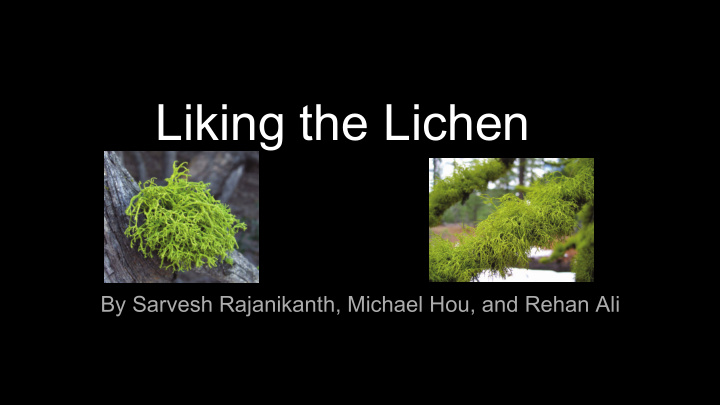



Liking the Lichen By Sarvesh Rajanikanth, Michael Hou, and Rehan Ali
Introduction Our project was based on lichen and trees and how they interact with each other. Lichen are important to the ecosystem and humans. They can absorb pollutants in our environment They help algae survive out of water as fungi protect them. Our curiosity led us to the following question, “What features and properties of trees allow them to be better hosts towards lichen?”
Background research Lichen is a symbiotic relationship between algae and fungi. There are many different types of lichen but the one that we were studying was called wolf lichen. Lichen uses trees as hosts and requires light,water, air and nutrients in order to survive. It also takes an extremely long time to grow. Wolf Lichen(Letharia vulpina) has yellowish-green fibers and it contains vulpinic acid that was used in Europe to kill wolves. We looked at lichen on lodgepole pine and fir trees.
Hypothesis The taller the tree, the more lichen will be on it. This is because sunlight will hit the taller trees first give more light to the lichen. If there is more area around the tree, the more lichen there would be on it. It is because there is more moisture in the air for water to absorb. Also because cyanobacteria in the air can provide nitrogen, a primary source of nutrients for the lichen. We believed that the deeper the bark indentations were, the more lichen there would be on the tree Because Lichen would have more grooves to latch onto.
Materials Materials for Research: a) Notebook b) Measuring Tape c) Soil Moisture/ Light Meter d) Clinometer e) Calculator f) Ruler
Methods Step 1: We measured moisture, light levels, and the open space area around each tree. Step 2: Measure the amount of lichen in the trees and categorize how much lichen is on each tree: For example: Lots of lichen, some lichen, and little lichen Step 3: Measure the height of the tree using the clinometer and the depth of the bark indentations on the tree.
Results We measured the amount of lichen on fir trees and lodgepole pine trees Average for fir trees= 34% Average for lodgepole pine trees= 13%
Results We compared the lichen coverage and area around tree in a scatter plot and added a trendline. r^2 value= 0.187
Results We compared the lichen coverage and the bark indentations r^2 value= 0.362 (left) The lichen coverage to the height of the trees r ^2 value= 0.681 (right)
Results Height by tree types Area around tree by tree types P=0.0040, T=3.2930, P=0.0014, T=3.7558, df=18 df=18
Discussion There was 21% more lichen on Fir trees than on Lodgepole trees. There was almost no relationship between the amount of area around the tree and the amount of lichen that grew on the tree or the depth of the bark indentations and the lichen coverage. When comparing the lichen coverage to the height of the trees, we found that these two elements of the project were correlated as the r^2 value was close to 1. This is because the r^2 value was 0.681.
Discussion(part 2) We concluded that there was a very significant difference between fir trees and lodgepole pine trees in lichen coverage, bark indentations, height, and the area around the tree.
Discussion(Part 3) Some parts of our hypothesis was true but other parts were false. The part that was correct was that the taller the tree, the more lichen there was on it. The parts in our hypothesis that was wrong was that the area around the tree and bark indentations did not caused greater lichen coverage.
Conclusion and Improvement We concluded that the factors most important for lichen growth was the height of the tree and the age of the tree as lichen takes an extremely long time to grow. In future experiments, we could add different species of trees and more trees in order to get more accurate results.
Recommend
More recommend